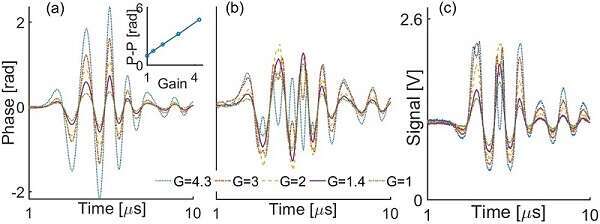
Ultrasound Detection via Optical Passive Pulse-Interferometry with a Large Dynamic Range
Optical detection of ultrasound is often characterized by limited dynamic range and lack of scalability. In this work, we present passive pulse interferometry as a solution to both challenges.
In the optical detection of ultrasound, high Q-factor resonators are often used to maximize sensitivity [1], compromising the linear range of the scheme, making it more susceptible to external perturbations and incapable of measuring strong acoustic signals [2,3]. Here presented a passive pulse interferometry (P-PI) scheme developed for high dynamic range measurements beyond the linear range of active pulse interferometry (A-PI) and CW interrogation (CW-I).
General pulse interferometry (PI) scheme is shown in Fig. 1a, whereas the specific schemes for A-PI and P-PI are shown in Figs. 1b and 1c, respectively. General CW-I scheme is shown in Fig. 1d. The optical resonator used as the ultrasound detection element was a π-phase-shifted fiber Bragg-grating (π-FBG). A wide-band pulse laser along with band-pass filters and an amplifier were used for interrogation in the PI schemes, with interrogation spectrum surrounding the resonance notch within the band-gap of the π-FBG. CW-I was performed by a tunable CW laser, tuned at half-maximum of the resonance of the π-FBG.

In the A-PI scheme, an unbalanced MZI was locked to quadrature point. In the P-PI scheme, the birefringence of PM fibers was utilized to detect phase shifts in a MZI that was not locked to quadrature. In this scheme, the output of the π-FBG was connected to a dual-polarization MZI, in which by careful selection of the lengths of each segment in the interferometer, the two outputs in Fig. 1c represent those of a 90° hybrid.
The performance of P-PI, A-PI, and CW-I was tested for different pressure levels ranging 124 kPa (G=1) to 533 kPa (G=4.3). In Fig. 2a, the signals measured with P-PI are expressed as the phase of the MZI transfer function. The inset shows linear dependency between the peak-to-peak values of the signals to the gain setting over a range of 4 rad. We present in Fig. 2b and Fig. 2c the signals measured by A-PI and CW-I, respectively, showing the folded signal at high gain levels, indicating their incompatibility with high dynamic-range measurements.

In conclusion, P-PI extends the applicability of PI for ultrasound detection to scenarios in which a high dynamic range is needed. In addition, all the components in our scheme may be fabricated in photonic circuits [4], making it scalable.
[1] T. Ling et al., Appl. Phys. Lett., 98, 204103 (2011).
[2] A. Rosenthal et al., Opt. Express, 20, 19016–19029 (2012).
[3] A. Rosenthal et al., Laser Photonics Rev., 8, 450–457 (2014).
[4] Y. Nasu et al., Opt. Express, 19, B112–B118 (2011).

Powered by Eventact EMS